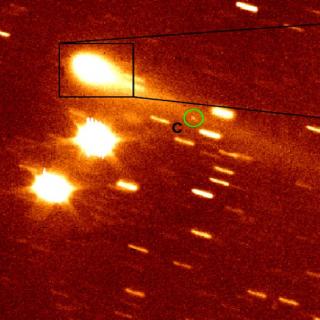Bibcode
Popescu, Marcel M.; Văduvescu, O.; de León, J.; de la Fuente Marcos, C.; de la Fuente Marcos, R.; Stănescu, M. O.; Alarcon, M. R.; Serra Ricart, M.; Licandro, J.; Berteşteanu, D.; Predatu, M.; Curelaru, L.; Barwell, F.; Jhass, K.; Boldea, C.; Aznar Macías, A.; Hudin, L.; Dumitru, B. A.
Bibliographical reference
Astronomy and Astrophysics
Advertised on:
8
2023
Journal
Citations
6
Refereed citations
5
Description
Context. Near-Earth asteroids (NEAs) that may evolve into impactors deserve detailed threat assessment studies. Early physical characterization of a would-be impactor may help in optimizing impact mitigation plans. We first detected NEA 2023 DZ2 on 27 February 2023. After that, it was found to have a minimum orbit intersection distance (MOID) with Earth of 0.00005 au as well as an unusually high initial probability of becoming a near-term (in 2026) impactor.
Aims: We perform a rapid but consistent dynamical and physical characterization of 2023 DZ2 as an example of a key response to mitigating the consequences of a potential impact.
Methods: We used a multi-pronged approach, drawing from various methods (observational-computational) and techniques (spectroscopy-photometry from multiple instruments), and bringing the data together to perform a rapid and robust threat assessment.
Results: The visible reflectance spectrum of 2023 DZ2 is consistent with that of an X-type asteroid. Light curves of this object obtained on two different nights give a rotation period P = 6.2743 ± 0.0005 min with an amplitude A = 0.57 ± 0.14 mag. We confirm that although its MOID is among the smallest known, 2023 DZ2 will not impact Earth in the foreseeable future as a result of secular near-resonant behaviour.
Conclusions: Our investigation shows that coordinated observation and interpretation of disparate data provides a robust approach from discovery to threat assessment when a virtual impactor is identified. We prove that critical information can be obtained within a few days after the announcement of the potential impactor.
Aims: We perform a rapid but consistent dynamical and physical characterization of 2023 DZ2 as an example of a key response to mitigating the consequences of a potential impact.
Methods: We used a multi-pronged approach, drawing from various methods (observational-computational) and techniques (spectroscopy-photometry from multiple instruments), and bringing the data together to perform a rapid and robust threat assessment.
Results: The visible reflectance spectrum of 2023 DZ2 is consistent with that of an X-type asteroid. Light curves of this object obtained on two different nights give a rotation period P = 6.2743 ± 0.0005 min with an amplitude A = 0.57 ± 0.14 mag. We confirm that although its MOID is among the smallest known, 2023 DZ2 will not impact Earth in the foreseeable future as a result of secular near-resonant behaviour.
Conclusions: Our investigation shows that coordinated observation and interpretation of disparate data provides a robust approach from discovery to threat assessment when a virtual impactor is identified. We prove that critical information can be obtained within a few days after the announcement of the potential impactor.
Spectrum, spectro-photometric data, and light-curves are only available at the CDS via anonymous ftp to cdsarc.cds.unistra.fr (ftp://130.79.128.5) or via https://cdsarc.cds.unistra.fr/viz-bin/cat/J/A+A/676/A126
Related projects

Minor Bodies of the Solar System
This project studies the physical and compositional properties of the so-called minor bodies of the Solar System, that includes asteroids, icy objects, and comets. Of special interest are the trans-neptunian objects (TNOs), including those considered the most distant objects detected so far (Extreme-TNOs or ETNOs); the comets and the comet-asteroid
Julia de
León Cruz